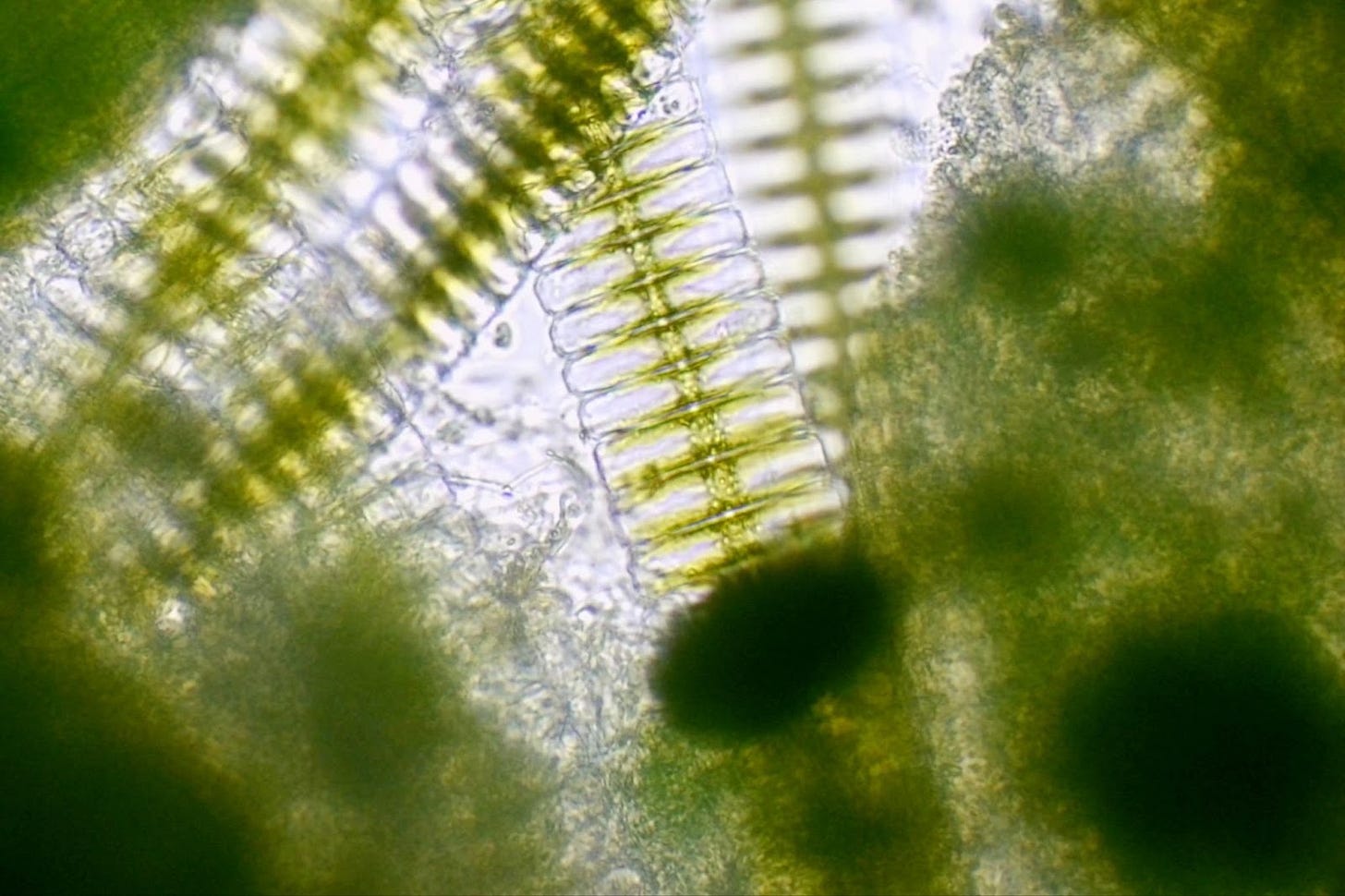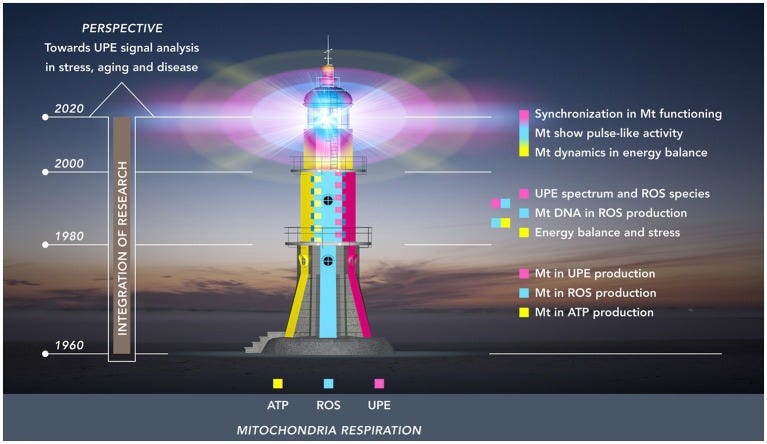Cells Make Light?!?
Also, microscopes are fun
About 10 years ago, I worked at the Exploratorium as a New Media Exhibit Developer for a couple of years. My job involved working on a team in the East Gallery — the living and biological systems. I didn’t realize it at the time, but this job would change the course of my art-making.
One project that I got drafted into was helping to revamp the Microscope Imaging Station. This is where you could control a live microscope in the bio lab with physical controls and a monitor. At first, I was like, sure, microscopes are cool. But then, when I looked at what was in a drop of seawater, my mind was boggled.
A decade later, I purchased my own microscope. I soon found myself getting pond samples, where you can find living critters, and posting “what is this” messages to a Reddit microscopy group. There are all sorts of things happening in this microworld that are utterly fascinating.
An image from my own microscope. I’m not even sure what this is!
Biophotons
Curiosity drives research, and while driving to a nature-based art residency in Oregon a few days ago, I listened to a Radiolab episode called Spark of Life. And this spark ignited my own imagination.
The interview is with Nirosha Murugan, a Canadian biophysicist, who is building on the work of many others, but is honing in on the studies of “biophotons” — small emissions of light that all living cells naturally emit.
Murugan had been trying to understand the intricate mechanisms of biology’s lock and key systems, which seemed inefficient for transmitting information. What can cells produce that reduces time to almost zero? Light!
So, she looked back at the famous experiments done by Russian scientist Alexander Gurwitsch back in the 1920s. Gurwitsch demonstrated that when two onion roots are placed in a common plane, the frequency of cell division (mitosis) increased in the region compared to the opposite side of the second root. He called it a “mitogenetic effect”. He demonstrated that the growth was stimulated by a very weak, ultraviolet light radiation (biophotons) emitted from the first root.
All Cells Produce Light
That’s right: all cells produce light. Not very much light, just a little bit. On the order of one photon every few seconds to minutes, depending on activity. Scientists need ultra-sensitive detectors to find these, nowhere close to the $20 off-the-shelf sensors I use.
The light can even be different wavelengths, like a glowing aura from your body, though, to be clear, “clairvoyants” could never see such a thing. But the analogy still holds.
Illuminating Mitochondrial Communication
So where is this light coming from? Most of us are familiar with mitochondria, tiny organelles found inside pretty much all living cells, and they are likely the producers of this. The mitochondria are the energy producers of cells. They produce the molecule called adenosine triphosphate (ATP) that fuels everything from our nerves and muscles to the synthesis of DNA. They also share information with the nucleus of the cell, particularly about reactive oxygen species (ROS) and other reactive metabolites derived from mitochondrial metabolism.
However, what is far lesser known is that mitochondria also release ultra-weak photon emissions (UPE), biophotons, between 300 and 900 nm (i.e., from UV to near-IR). These have been reported from all kinds of cells, small organisms, and even human skin.
Image source: Van Wijk et al. (2020), Frontiers in Physiology.
Licensed under CC BY 4.0.
https://pmc.ncbi.nlm.nih.gov/articles/PMC7360823/
The Mystery of Biophotonic Emissions
We don’t know why these biophotonic emissions are happening, but they most certainly are. While some scientists allege that this is just noise, biology doesn’t expend energy simply for no reason. We just don’t yet understand its reason. I suspect that it is some sort of signaling mechanism for body regulation. Light is fast, efficient, and can encode information as frequency and wavelengths. These emissions are also happening inside the body itself.
This ability of mitochondria to emit light could explain why new physical therapies using low-intensity light therapy (LILT - lasers) or photobiomodulation (PBM) therapy are being used to treat acute and chronic musculoskeletal conditions. It’s because when you apply these low-intensity light therapies, it raises the level of ATP within the mitochondria, and photoacceptors convert the light to influence cellular functions, including gene expression, growth and proliferation, survival, and differentiation. But there’s even more these mighty mitochondria can do.
Early Cancer Detection
Murugan’s research is looking at photonic biosignatures and applications in the human body, such as distinguishing cancer cells from normally functioning ones. This, of course, would be an amazing advance in medicine: early cancer detection.
Studies show that mitochondria emit biophotons in relation to the oxidative metabolism involving Reactive Oxygen Species (ROS), which themselves have numerous fundamental signal roles in cellular processes. Biophotons also interact with microtubules, which are responsible for the rapid movements of the mitochondria.
What this means is that biophoton emission may not be simply a byproduct of biochemical processes, but instead can be linked to precise signaling pathways of ROS, microtubules, and can produce regulated biophotons within cells and neurons. The absorption of biophotons by a nearby photosensitive molecule can produce an electronically excited state, exciting nearby molecules and triggering or regulating complex signal processes. It is this ultra-weak photon emission (UPE) language of mitochondria that is being investigated across numerous studies now for use in cancer detection.
The Secret Language of Cells
Returning to my fascination with the microworld, I am curious about the cells themselves. What is the mechanism? If all living creatures have a potential light signaling mechanism, what is it regulating? Would each of us have a hidden, internal communication system? Is there a standard language?
As with many things biological, the more I learn, the more questions I have than answers, and I find this to be thrilling.




Very interesting.
(Your micrograph appears to show algae, specifically Desmidium swartzii.)